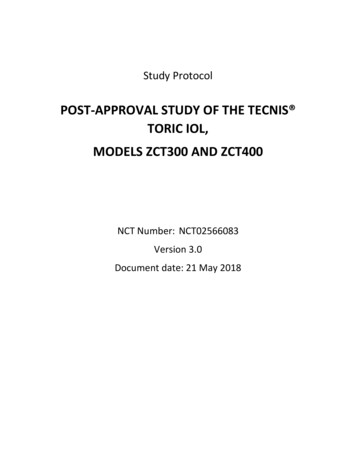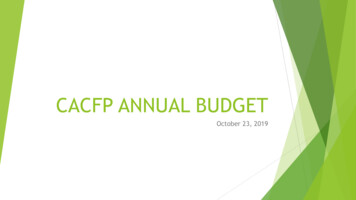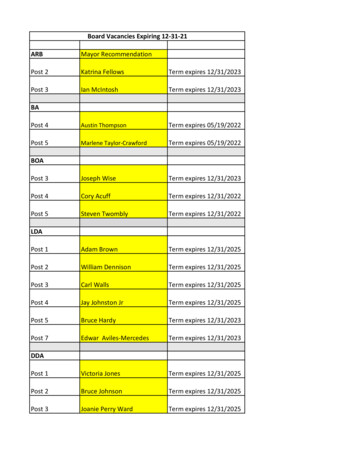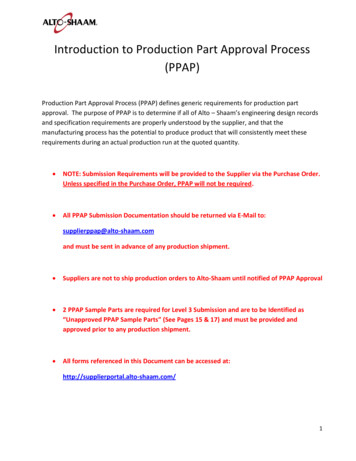
Transcription
Study ProtocolPOST-APPROVAL STUDY OF THE TECNIS TORIC IOL,MODELS ZCT300 AND ZCT400NCT Number: NCT02566083Version 3.0Document date: 21 May 2018
ABBOTT MEDICAL OPTICS INC.CONFIDENTIALCONFIDENTIALThe following contains confidential, proprietary informationthat is the property of Abbott Medical Optics Inc.POST-APPROVAL STUDY OF THE TECNIS TORIC IOL,MODELS ZCT300 AND ZCT400PROTOCOL NUMBER: TIOL-202-TPASSPONSOR: Abbott Medical Optics Inc.1700 E. Saint Andrew PlaceSanta Ana, CA 92705 USA(714) 247-8200Investigator Agreement:As an Investigator, I agree to: Implement and conduct this study diligently and in strict compliance with thisagreement; the protocol; Good Clinical Practices; 21CFR812 and all otherapplicable FDA regulations; conditions of approval imposed by the reviewingInstitutional Review Board (IRB) or FDA; and all other applicable laws andregulations. Supervise all testing of the device where human subjects are involved. Ensure that the requirements for obtaining informed consent are met. Obtain authorization for use/disclosure of health information (HIPAAauthorization).Maintain all information supplied by Abbott Medical Optics in confidence and,when this information is submitted to an independent IRB or any other group,it will be submitted with a designation that the material is confidential.I have read this protocol in its entirety and I agree to all aspects.Investigator Printed NameSignatureDateSub-Investigator Printed NameSignatureDateSub-Investigator Printed NameSignatureDateAcknowledged By:Signature of Sponsor’s RepresentativeDatePrinted Name and TitleVersion 3.0PR/TIOL-202-TPAS
ABBOTT MEDICAL OPTICS INC.CONFIDENTIALTABLE OF CONTENTSSECTIONTITLEPAGEPERSONNEL AND FACILITIES . 3PROTOCOL CHANGE HISTORY . 41.0SYNOPSIS . 52.0BACKGROUND AND PURPOSE OF STUDY .103.0STUDY OBJECTIVE .114.0STUDY DESIGN .115.0CLINICAL HYPOTHESIS .116.0STUDY ENDPOINTS .117.0STUDY PRODUCTS .127.1INTRAOCULAR LENSES .127.2IMPLANTATION SYSTEMS .148.0STUDY POPULATION .158.1SUBJECT RECRUITMENT .158.2INCLUSION CRITERIA: .158.3EXCLUSION CRITERIA: .169.0INVESTIGATOR/SITE SELECTION .169.1INVESTIGATOR QUALIFICATIONS .179.2INVESTIGATOR OBLIGATIONS .179.3INVESTIGATOR APPROVAL .1810.0 STUDY TIMELINE .1911.0 EXPERIMENTAL PLAN .1911.1 OVERVIEW .1911.2 VISIT SCHEDULE .2111.3 PREOPERATIVE PROCEDURES .2111.4 OPERATIVE PROCEDURES .2411.5 POSTOPERATIVE PROCEDURES .2511.6 UNSCHEDULED VISIT(S) FOR ADVERSE EVENT OR SPONTANEOUSREPORT OF VISUAL DISTORTION(S).2711.7 SUBJECT FOLLOW-UP AND DISCONTINUATION .2812.0 ADVERSE EVENTS AND PRODUCT COMPLAINTS .3012.1 ADVERSE EVENT AND COMPLAINT DEFINITIONS .3012.2 ADVERSE EVENT REPORTING REQUIREMENTS .3212.3 ADVERSE EVENT FOLLOW-UP .3312.4 RELATIONSHIP TO STUDY DEVICES .3313.0 PROTOCOL CHANGES AND PROCEDURES .3414.0 ETHICS REVIEW AND PATIENT WELFARE .3414.1 INSTITUTIONAL REVIEW BOARD (IRB) .3414.2 INFORMED CONSENT .3515.0 DOCUMENTATION .3515.1 SOURCE DOCUMENTS .3515.2 SUBJECT CONFIDENTIALITY.3615.3 CASE REPORT FORM COMPLETION .3616.0 MONITORING PROCEDURES.3716.1 DATA MONITORING .37Version 3.01PR/TIOL-202-TPAS
ABBOTT MEDICAL OPTICS INC.CONFIDENTIAL16.2 ADMINISTRATIVE MONITORING.3716.3 MEDICAL OVERSIGHT.3817.0 PUBLICATIONS .3918.0 RECORDS RETENTION .3919.0 TERMINATION OF THE STUDY .3920.0 DATA ANALYSIS AND REPORTING .4020.1 ANALYSIS POPULATIONS .4120.2 PRIMARY ENDPOINT ANALYSIS.4120.3 OTHER VISUAL DISTORTION ENDPOINT ANALYSES .4220.4 OTHER ENDPOINT ANALYSES .4220.5 ADDITIONAL ANALYSES AND DATA CONVENTIONS.4320.6 SAMPLE SIZE .4320.7 DATA REPORTING REQUIREMENTS .4321.0 REFERENCES .44APPENDIX A SUMMARY OF EXAMINATIONS .45APPENDIX B STUDY QUESTIONNAIRE .46APPENDIX C .54TORIC IOL AXIS MEASUREMENT AT SLIT LAMP .54APPENDIX D SLIT-LAMP EXAM RATINGS.55APPENDIX E ADVERSE EVENT REPORTING INSTRUCTIONS .57ATTACHMENT A SAMPLE STUDY INFORMED CONSENT .58ATTACHMENT B .68SAMPLE AUTHORIZATION FOR USE/DISCLOSURE OF HEALTH INFORMATIONFORM .68Version 3.02PR/TIOL-202-TPAS
ABBOTT MEDICAL OPTICS INC.CONFIDENTIALPERSONNEL AND FACILITIESMEDICAL MONITOR:Joy Domingo, MDGlobal Medical DirectorAbbott Medical Optics Inc.Santa Ana, CA 92705Office Number: 714-247-8992SPONSOR:Abbott Medical Optics Inc.1700 E. Saint Andrew PlaceSanta Ana, CA 92705Main Number: 714-247-8200Fax: 714-247-8784SPONSOR PERSONNEL:Director Clinical Research,CataractDebbie TrentacostOffice: 714-247-8625Study Manager:Rosangela Nolasco, DMD, MPHClinical Research ManagerOffice: 714-247-8624EMERGENCY TELEPHONE NUMBERS:Rosangela NolascoOffice: 714-247-8624Cell: 949-280-0620Version 3.03PR/TIOL-202-TPAS
ABBOTT MEDICAL OPTICS INC.CONFIDENTIALProtocol Change HistoryVersion1.0 (31 AUG15/F(A1)2.0Section(s)N/A1.0 SynopsisPage(s)N/A58.0 Study Population15Attachment A: Informed ConsentVersion 3.0Description of Change(s)OriginalChanged number of subject to beenrolled from 435 to 475Rationale for Change(s)N/ACurrent screen failure rate is 14%; theincrease in subject enrollment will ensurethe ability to achieve bilateral implantation of385 subjects.Dates were modified to extend enrollmentfrom August 2017 until April 2018. This isnecessary to allow time to enroll 40 moresubjects due to higher-than-anticipatedScreen Failure Rate. All other analyses andreporting dates were modified as well.Although recommended, there is not aninclusion criteria for potential visual acuityand this note was included in error.Improved tracking of versions5910.0 Study Timelines, Table 319Changed expected timelines11.3 Preoperative Procedures21Footer: Changed footer to comply withcurrent standardsAllRemoved note for 20/30 or betterpredicted best-corrected distancevisual acuityRemoved dates and placedversion number4PR/TIOL-202-TPAS
ABBOTT MEDICAL OPTICS INC.3.0Version 3.0CONFIDENTIALPersonnel and Facilities3Updated medical monitorinformation.Removed Dr. David Tanzer and replacedwith current medical monitor, Dr. JoyDomingo.1.0 Synopsis6, 7Changed number of subjects to beenrolled and treated.8.0 Study Population15The number of subjects required to provethe hypothesis is much smaller thanoriginally calculated.20.6 Sample Size43Changed sample size calculationsAttachment A: Informed Consent61Changed number of subjectsenrolled and treated.A revised sample size calculation was madefollowing an interim analysis using currentrates of severe visual distortions.Modified to keep consistent with protocolwording,5PR/TIOL-202-TPAS
ABBOTT MEDICAL OPTICS INC.1.0CONFIDENTIALSYNOPSISSTUDY TITLE:Post-Approval Study of the TECNIS Toric IOL,Models ZCT300 and ZCT400Protocol: TIOL-202-TPASSTUDY TREATMENTS:Toric Study Lenses: TECNIS Toric 1-Piece IOL, Model ZCT300 (andPCT300) TECNIS Toric 1-Piece IOL, Model ZCT400 (andPCT400)The ZCT300 and ZCT400 lens models (as well asPCT300 and PCT400) are intended for cataractpatients with pre-existing corneal astigmatism that,when surgically induced astigmatism (SIA) is takeninto account, have approximately 2.00 D to 3.62 D ofpredicted corneal astigmatism to be corrected.Note: The PCT models (PCT300 and PCT400) arethe same IOLs as the ZCT models with the exceptionthat they are provided preloaded in the TECNIS iTecDelivery System. For reference in this protocol, PCTis the same as ZCT.Control Lens: TECNIS Monofocal 1-Piece IOL, Model ZCB00(and PCB00)Note: Model PCB00 is the Model ZCB00 IOLpreloaded into the TECNIS iTec Delivery System andmay also be used as the control lens. For referencein this protocol, PCB00 is the same as ZCB00.STUDY OBJECTIVE:Version 3.0The purpose of this post-approval study is toevaluate the rates of visual distortions for theTECNIS Toric IOLs with 2.0 D of cylinder correctionat the corneal plane (Models ZCT300 and ZCT400)in a larger population in clinical practice compared to5PR/TIOL-202-TPAS
ABBOTT MEDICAL OPTICS INC.CONFIDENTIALa non-toric control IOL and to ensure the continuedsafety of the approved devices.CLINICAL HYPOTHESIS:The rate of severe visual distortions for the TECNISToric IOL Models ZCT300 and ZCT400 will be lessthan 10 percentage points above that for a non-toriccontrol group with the same level of preoperativecorneal astigmatism.OVERALL STUDY DESIGN:Structure:Prospective, multi-center, bilateral, non-randomized,open-label, comparative clinical studyNumber of Sites:Up to 80 sites in the USADuration:Six months; however, any subjects that undergo alens repositioning procedure due to IOL misalignmentor that report a severe visual distortion at six months,will be followed through 1 year postoperatively.Administration:Emmetropia will be targeted for both eyes. Surgeonswill perform routine small-incision,phacoemulsification cataract surgery and use theAMO-recommended implantation systems for lensimplantation.Visit Schedule:Subjects will be bilaterally implanted; the second eyeis to be implanted within approximately one monthafter the first eye surgery.Subjects will undergo two postoperative visits at1 month and 6 months for both eyes together. If asubject experiences a lens repositioning procedurefor IOL misalignment or if a subject reports a severevisual distortion at 6 months, the subject will alsoundergo a final visit at 1 year.STUDY POPULATION:Condition:Bilateral cataracts with corneal astigmatism ofapproximately 2.00 D to 3.62 D based on thecombination of preoperative keratometric cylinderand the expected effect of SIA.Number of subjects:A minimum of 396 subjects will be enrolled toachieve bilateral implantation in approximately 294Version 3.06PR/TIOL-202-TPAS
ABBOTT MEDICAL OPTICS INC.CONFIDENTIALsubjects: 169 TECNIS Toric ZCT300 and ZCT400subjects (including a minimum of approximately 30%,or 51, ZCT400 subjects) and 125 control subjects(assumes a 10% drop-out rate for a minimum of 152toric and 112 control subjects available for evaluationat 6 months). Subjects will choose to be implantedwith the same lens in both eyes, either the toric IOLsor the non-toric control IOL.Inclusion Criteria: Minimum 22 years of age Bilateral cataracts for which phacoemulsification extraction and posteriorchamber IOL implantation have been planned Preoperative keratometric cylinder in both eyes that, when taking surgicallyinduced astigmatism into account, have approximately 2.00 D to 3.62 D ofpredicted corneal astigmatism to be corrected and qualify for implantation ofZCT300 and/or ZCT400 IOLs as determined by the web-based AMO Toric IOLCalculatoro Most appropriate toric IOL model choice (ZCT300 or ZCT400)based on the associated residual refractive cylinder (lowest) andaxiso Predicted residual refractive cylinder, based on the AMO Toric IOLCalculator, must be: 0.69 D for a ZCT300 IOL 0.88 D for a ZCT400 IOL Clear intraocular media other than cataract in each eye Availability, willingness, ability and sufficient cognitive awareness to comply withexamination procedures and study visits Ability to understand, read and write English in order to consent to studyparticipation and complete a study questionnaire Signed informed consent and HIPAA authorizationExclusion Criteria: Irregular corneal astigmatism Any corneal pathology/abnormality other than regular corneal astigmatism Previous corneal surgery Recent ocular trauma or intraocular surgery that is not resolved/stable or mayaffect visual outcomes Any pupil abnormalities (non-reactive, fixed pupils, or abnormally shaped pupils)Version 3.07PR/TIOL-202-TPAS
ABBOTT MEDICAL OPTICS INC.CONFIDENTIAL Subjects with conditions associated with increased risk of zonular rupture,including capsular or zonular abnormalities that may lead to IOL decentration,including pseudoexfoliation, trauma, or posterior capsule defects Known ocular disease or pathology that may affect visual acuity or that mayrequire surgical intervention during the course of the study (maculardegeneration, cystoid macular edema, diabetic retinopathy, uncontrolledglaucoma, etc.) Concurrent participation or participation during 30 days prior to preoperative visitin any other clinical study Planned monovision correction Patient is pregnant, plans to become pregnant, is lactating or has anothercondition associated with the fluctuation of hormones that could lead to refractivechangesSTUDY ENDPOINTS:Study endpoints will be evaluated at 6 months postoperatively.Primary Endpoint:Rate of severe visual distortions; defined as the percentage of subjects who report asevere visual distortion under overall circumstances at 6 months postoperative for any ofthe following 5 visual distortion items of interest:ooooolines that slant, tilt, split or separateflat surfaces appearing curvedobjects appearing further away or closer than they actually areobjects appearing to have a different size or shapephysical discomfort related to visionOther Endpoints: Ratings of individual items included on the visual distortion questionnaire Rates of IOL repositioning procedures (secondary surgical intervention) due toIOL misalignment Rates of other adverse eventsVISITS AND PROCEDURES:All subjects enrolled in the study will sign the IRB-approved informed consent prior toany study-specific testing or administration of the questionnaire. Each subject willchoose to receive the same lens type in both eyes, either the TECNIS Toric IOLs(Models ZCT300 and/or ZCT400), or the non-toric control IOL (TECNIS Model ZCB00).VISIT SCHEDULE: All subjects are intended to have bilateral cataract surgery with thesecond-eye surgery occurring within approximately 1 month of the first-eye surgery( 60 days). Two postoperative study visits will be conducted; at 1 monthVersion 3.08PR/TIOL-202-TPAS
ABBOTT MEDICAL OPTICS INC.CONFIDENTIAL(30-60 days after the second-eye surgery) and at 6 months (120-180 days after thesecond-eye surgery) for both eyes together. However, subjects who underwent an IOLrepositioning procedure due to IOL misalignment or who reported a severe visualdistortion at 6 months will return for a final visit at 1 year (330-420 days after thesecond-eye surgery) postoperatively.PREOPERATIVE PROCEDURES: Following informed consent, a subject questionnairefor determination of visual distortions will be administered (Patient Reported VisualDistortion Questionnaire; PRVDQ). Demographic, general preoperative and operativeinformation will be collected from routine cataract evaluation examinations and surgicalreports.POSTOPERATIVE PROCEDURES: At the 1-month visit, a spectacle and/or contactlens prescription will be offered to each subject. If the subject has a spontaneous reportof any of the 5 defined visual distortion items of interest or of blurred or hazy vision, thequestionnaire will be administered and, for subjects with toric IOLs, keratometry and toricIOL axis measurements will be performed.At the 6-month visit, the postoperative procedures will include a subject questionnaire(Patient Reported Visual Distortion Questionnaire; PRVDQ) for determination of visualdistortions, biomicroscopic slit-lamp examination for any adverse events and, forsubjects with toric IOLs, determination of toric IOL axis position and keratometry.If outside of a scheduled study visit, a subject has a spontaneous report of; 1) any of the5 defined visual distortion items of interest or 2) blurred or hazy vision at 1 monthpostoperatively or later, the PRVDQ questionnaire will be administered and, for subjectswith toric IOLs, keratometry and toric IOL axis measurements will be performed. Examdetails will be documented on an unscheduled visit form.If a subject reported a severe visual distortion in the questionnaire or experienced anocular adverse event at any scheduled or unscheduled study visit, uncorrected distancevisual acuity, best corrected distance visual acuity, manifest refraction, slit-lampexamination and intraocular pressure measurements will also be performed.A 1-year examination will be required only if the subject reports a severe visual distortionat the 6-month examination or experienced an IOL repositioning procedure (due to IOLmisalignment during the study).If a serious or device-related adverse event occurs at or prior to the 6-month visit, detailsof the event will be collected at the time of the event using an adverse event form. If theadverse event is an IOL misalignment resulting in an IOL repositioning procedure, thequestionnaire is to be administered prior to the repositioning procedure to collectinformation regarding visual distortions, and, for subjects with toric IOLs, keratometryand toric IOL axis measurements will be performed prior to the repositioning procedureto collect data regarding the IOL misalignment.Version 3.09PR/TIOL-202-TPAS
ABBOTT MEDICAL OPTICS INC.CONFIDENTIALDATA ANALYSIS:The rate of severe visual distortions as defined by the 5 items listed under primaryendpoint will be compared between bilaterally-implanted toric IOL subjects andbilaterally-implanted non-toric control IOL subjects at 6 months. The frequency andproportion of toric and non-toric control subjects with severe visual distortions will bereported. Results between the toric IOL and the non-toric control IOL groups will beevaluated using a non-inferiority approach with a non-inferiority margin of 10%.Assessment of toric IOL axis misalignment will be compared to reports of visualdistortions.The frequency and proportion of secondary surgical interventions due to IOLmisalignment, as well as rates for other adverse events or medical and lens findings, willbe reported by treatment group. Evaluation at 6 months will include reporting bytreatment groups the incidence of all adverse events, including severity for seriousadverse events and adverse device effects.Visual distortion findings, adverse events and medical/lens findings at one year will bereported for subjects who experienced a repositioning procedure during the study or forsubjects who were reported with severe visual distortions at the 6-month visit.2.0BACKGROUND AND PURPOSE OF STUDYIt is estimated that 35% of cataract patients have 1.00 diopter of corneal astigmatism1with 15%-20% having 1.5 D of corneal astigmatism.1,2 Although there are variousmodalities to reduce the amount of astigmatism during cataract surgery (e.g., limbalrelaxing incisions, etc.), toric IOLs are now commonly used for correction of aphakia andpre-existing ocular astigmatism. On April 15, 2013, Abbott Medical Optics (AMO)received USA FDA approval (P980040/S039) for the TECNIS 1-Piece Toric IOL, ModelsZCT150, ZCT225, ZCT300 and ZCT400 for the visual correction of aphakia and preexisting corneal astigmatism of one diopter or greater.In the IDE registration trial of the TECNIS 1-Piece Toric IOL (G090251), rotationalstability was demonstrated and there were minimal subject complaints of visualdistortions; however, there is the potential, particularly in the case of toric IOLs thatcorrect for higher amounts of corneal astigmatism, that patients may experience spatialdistortions related to axis misalignment, e.g., whether objects appear tilted ormisshapen, etc. As a condition of approval, this post-approval study will be conducted toVersion 3.010PR/TIOL-202-TPAS
ABBOTT MEDICAL OPTICS INC.CONFIDENTIALevaluate visual distortions of the TECNIS Toric 1-Piece IOLs with 2.00 D of cylindercorrection at the corneal plane (Models ZCT300 and ZCT400) and to ensure thecontinued safety of the approved devices.3.0STUDY OBJECTIVEThe objective of this post-approval study is to evaluate the rates of severe visualdistortions for the TECNIS 1-Piece Toric IOLs with 2.0 D of cylinder correction at thecorneal plane (Models ZCT300 and ZCT400) in a larger population in clinical practicecompared to a non-toric, control IOL, and to ensure the continued safety of the approveddevices.4.0STUDY DESIGNThis study is a prospective, multicenter, bilateral, non-randomized, open-label,comparative clinical study conducted at up to 80 sites in the USA. Subjects will chooseto be bilaterally implanted with either 1) the TECNIS 1-Piece Toric IOLs, Model ZCT300and/or ZCT400, or 2) the TECNIS Monofocal Model ZCB00 non-toric control IOL,according to subject preference.5.0CLINICAL HYPOTHESISThe rate of severe visual distortions for the TECNIS 1-Piece Toric IOL Models ZCT300and ZCT400 will be less than 10 percentage points above that for the non-toric controlIOL group with the same level of preoperative corneal astigmatism.6.0STUDY ENDPOINTSStudy endpoints will be evaluated at 6 months postoperatively.PRIMARY ENDPOINTThe primary endpoint is the rate of severe visual distortions based on data collectedfrom a self-administered subject questionnaire (PRVDQ).Version 3.011PR/TIOL-202-TPAS
ABBOTT MEDICAL OPTICS INC.CONFIDENTIALThe rate of severe visual distortions is defined as the percentage of subjects who reporta severe visual distortion under overall circumstances at 6 months postoperative for anyof the following 5 visual distortion items of interest:ooooolines that slant, tilt, split or separateflat surfaces appearing curvedobjects appearing further away or closer than they actually areobjects appearing to have a different size or shapephysical discomfort related to visionDistortions will be assessed using the overall circumstance reply at the6-month visit. The frequency and proportion of subjects reporting one ormore of these items as severe will be used to determine the rate ofsevere visual distortions.Success criteria: Rates of severe visual distortions for the TECNIS 1-PieceToric IOL group will be less than 10 percentage points aboverates for the non-toric control IOL group.OTHER ENDPOINTS Ratings of individual items included on the visual distortion questionnaire Rates of IOL repositioning procedures (secondary surgical intervention) due toIOL misalignment Rates of other adverse events7.0STUDY PRODUCTS7.1INTRAOCULAR LENSESThe TECNIS 1-Piece Toric IOL, Models ZCT300 and ZCT400, and the TECNIS 1-PieceModel ZCB00 non-toric control IOL are posterior chamber, 1-piece, aspheric,hydrophobic acrylic foldable IOLs and are to be implanted in the capsular bag followingcataract extraction. Both the TECNIS 1-Piece Toric IOLs and the TECNIS 1-Piecemonofocal non-toric IOL, Model ZCB00, have an anterior aspheric optic surface and aspherical posterior optic surface; however, the TECNIS 1-Piece Toric IOLS have anadditional toric feature on the anterior optic surface to correct for ocular astigmatism.The TECNIS 1-Piece Toric IOLs are indicated for the visual correction of aphakia andpre-existing corneal astigmatism of one diopter or greater in adult patients with andwithout presbyopia in whom a cataractous lens has been removed by extracapsularcataract extraction, and who desire improved uncorrected distance vision, reduction inresidual refractive cylinder, and increased spectacle independence for distance. TheVersion 3.012PR/TIOL-202-TPAS
ABBOTT MEDICAL OPTICS INC.CONFIDENTIALZCT300 and ZCT400 lens models, in particular, are intended for cataract patients withpre-existing corneal astigmatism that, when taking surgically induced astigmatism intoaccount, have approximately 2.00 D to 3.62 D of predicted corneal astigmatism to becorrected (Table 1).Note: The PCT models (PCT300 and PCT400) are the same IOLs as the ZCT modelswith the exception that they are provided preloaded in the TECNIS iTec DeliverySystem. Similarly, Model PCB00 is the Model ZCB00 IOL preloaded into the TECNISiTec Delivery System and may also be used as the control lens. For reference in thisprotocol, PCB00 is the same as ZCB00, and the PCT models are the same as the ZCTmodels.TABLE 1TECNIS Toric Models ZCT300 and ZCT400 IOL Astigmatism Correction RangeZCT IOLModelabZCT300ZCT400Cylinder Power (D)IOL Plane3.004.00Keratometric cylinderSurgically induced astigmatismCorneal Plane2.062.74Correction Range Based onCombined Corneal Astigmatism(Preoperative Kcyla SIAb)2.00 – 2.75 D2.75 – 3.62 DThe TECNIS 1-Piece Toric IOLs have two sets of four axis orientation marks 180o apartin the outer periphery of the anterior optic surface (Figure 1) to indicate the meridian ofthe lowest power (flat meridian). These axis orientation marks are for proper alignmentof the flat meridian of the IOL with the steep meridian of the corneal curvature.FIGURE 1TECNIS Toric IOL Illustration of Axis Orientation MarksVersion 3.013PR/TIOL-202-TPAS
ABBOTT MEDICAL OPTICS INC.CONFIDENTIALTable 2 lists the general design characteristics of the non-toric control IOL and theTECNIS 1-Piece Toric IOLs:TABLE 2Lens Characteristics of the TECNIS Model ZCB00 andTECNIS Toric Models ZCT300 and ZCT400CHARACTERISTICSLens DesignLens ModelTECNIS 1-Piece IOLModel ZCB00 (Control)1-piece acrylic monofocal with anaspheric anterior surfaceSurface-treated SENSAR softacrylic (acrylic with covalently boundUV absorber)DIMENSIONAL FEATURESOverall DiameterOptical Center Thickness1-piece acrylic monofocal with anaspheric anterior surface and amaximum and a minimum radii ofcurvature perpendicular to eachotherSame as Model ZCB00Same as Model ZCB00Same as Model ZCB00Other Features13.0 mm0.722 mm (20.0 D Lens)No angulation, but offset from theoptic body6.0 mmSame as optic0.39 mm0.46 mmTRI-FIX Design Modified C, integralwith opticN/AOptic ShapeBiconvexAnterior Optic ProfileAsphericSame as Model ZCB00Aspheric with a maximum and aminimum radii of curvatureperpendicular to each otherSame as Model ZCB00Same as Model ZCB00Same as Model ZCB003.00 D, 4.00 D (at the IOL plane)Same as Model ZCB00Same as Model ZCB00Haptic AngleOptic Body DiameterHaptic Material
ZCT300 and/or ZCT400 IOLs as determined by the web-based AMO Toric IOL Calculator o Most appropriate toric IOL model choice (ZCT300 or ZCT400) based on the associated residual refractive cylinder (lowest) and axis o Predicted residual refractive cylinder, based on the AMO Toric IOL Calculator, must be: 0.69 D for a ZCT300 IOL











